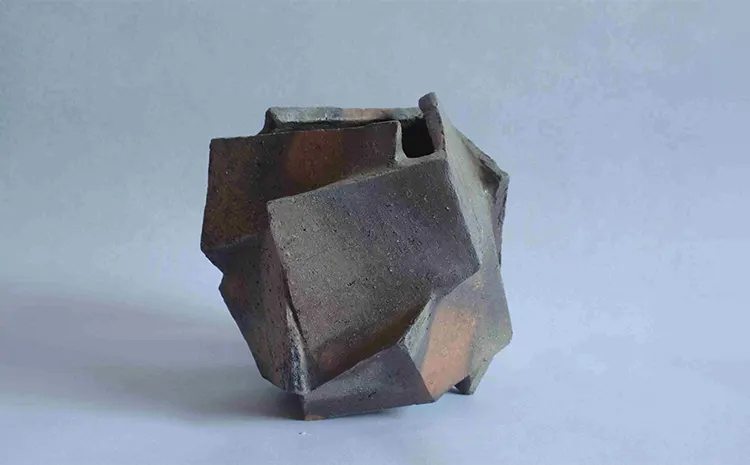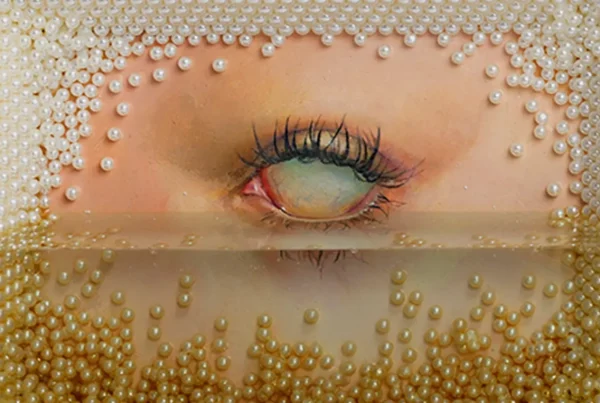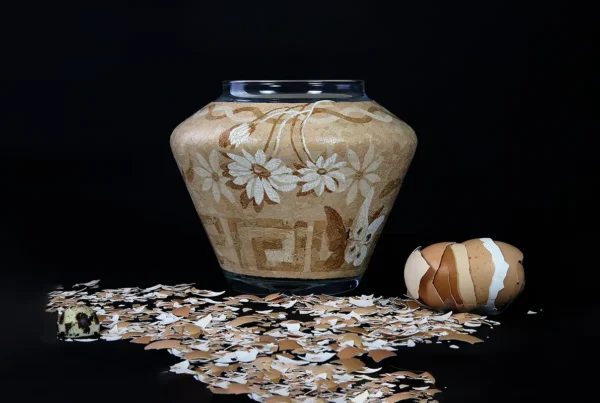“The most important thing is to keep working.”
A Journey Ignited by Curiosity
Hiroshi Toyofuku first found his curiosity piqued by the Japanese traditional folk performing arts during his tenure at university. This burgeoning interest opened a new realm of exploration into the diverse regional cultures of Japan, ultimately setting the groundwork for the artist’s current oeuvre.
An unexpected turning point for Toyofuku, the discovery of ancient Jomon-style pottery in the confines of his university campus, occurred following his graduation. At this juncture in his life, he was yet to develop a fondness for ceramics and was considering various career options. The notion of crafting tangible creations with his own hands held a particular allure.
The ancient pottery discovery kindled an interest in unglazed, fired pottery, drawing Toyofuku toward the concept of wood-fired kilns. This spark ignited a journey, leading him to Bizen, a place renowned for its rich tradition in ceramics. There, he diligently sought knowledge under the guidance of an accomplished local potter at a training institute, dedicating himself wholly to mastering the intricate nuances of the craft.
Following a decade-long apprenticeship, a period marked by unwavering commitment and hands-on learning, Toyofuku established his own kiln. This significant step marked the onset of his independent artistic journey, paving the way for him to further shape and contribute to the world of ceramics with his unique creative vision.
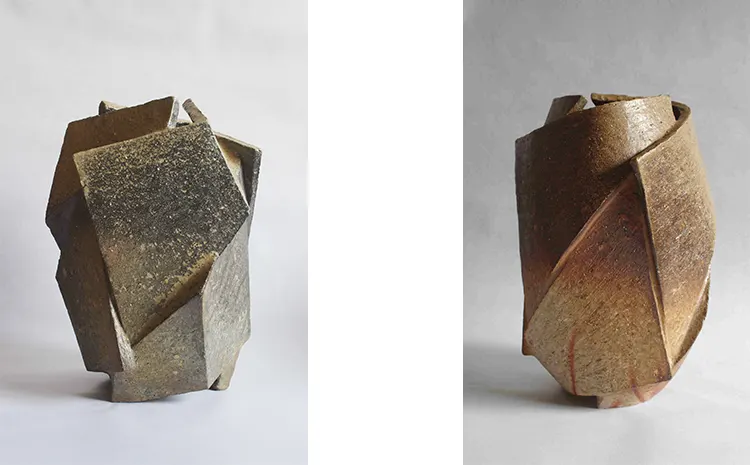
Hiroshi Toyofuku: Shaping Nature’s Design with Clay
In the incipient stage of Hiroshi Toyofuku’s career, he pursued the swift creation of pottery, targeting high-volume production. Efficiency and effectiveness governed his aesthetic choices, as he aspired to conceive designs that demanded minimal investment of time and effort. Over time, however, Toyofuku experienced an evolution in his artistic predilections, finding himself inexorably drawn toward endeavors that warranted a greater allocation of time and concentration.
Presently, Toyofuku’s work stands as a testament to a profound kinship with the clay he molds. His central aim lies in articulating the intrinsic essence of the clay, bringing forth its marbled and layered surface—a visual echo of its natural state at the point of extraction. This manifestation of nature’s design bears an intense power and complexity that is innately compelling.
In order to accentuate these characteristics, Toyofuku intentionally designs shapes that spotlight the clay’s unique features. His compositions might be interpreted as intricate tapestries of overlapping surfaces, yet their genesis is rooted in simplicity, originating from the layering of string-like clay.
By leveraging the potential of wood-fired kilns, Toyofuku continually pushes the boundaries of Bizen Pottery. He persistently explores the art form’s aesthetic potential, thus expanding its artistic possibilities in an ever-evolving dialogue with the material world.

The Creative Sanctum and its Inspirations
In the Hiroshi Toyofuku’s creative sanctuary, the ambient noise serves as a symphony, curating the perfect conditions conducive to his deep artistic immersion. This carefully crafted atmosphere provides him the ideal backdrop to extract inspiration. Nevertheless, Toyofuku is keenly aware of the potential distractions that may disrupt his creative momentum. He holds the philosophy that occasional intermissions are crucial to refocus his artistic vision and rejuvenate his creative energy.
Toyofuku’s artistic philosophy owes a substantial debt to the teachings of his mentor, a master Bizen potter who welcomed him into the world of ceramics. Under this master’s tutelage, Toyofuku inherited a potent ethos: relentless perseverance and unwavering dedication to the craft stand paramount. The consistent reinforcement of these principles emphasized the indispensability of continuous practice and refinement of skills.
Of the many influences in Toyofuku’s repertoire, the antiquity of old Chinese bronzes hold an unparalleled position. Their presence is strongly felt in Japanese ceramics, a domain where the freedom to mold clay often gives birth to imitative art. The old Chinese bronzes, in particular, have evolved as a recurrent theme in this genre. Toyofuku finds himself profoundly drawn to their distinctive shapes, fused with the strength and unique texture of the material. These attributes strike a deep chord within him, invoking feelings of reverence and eliciting profound inspiration.
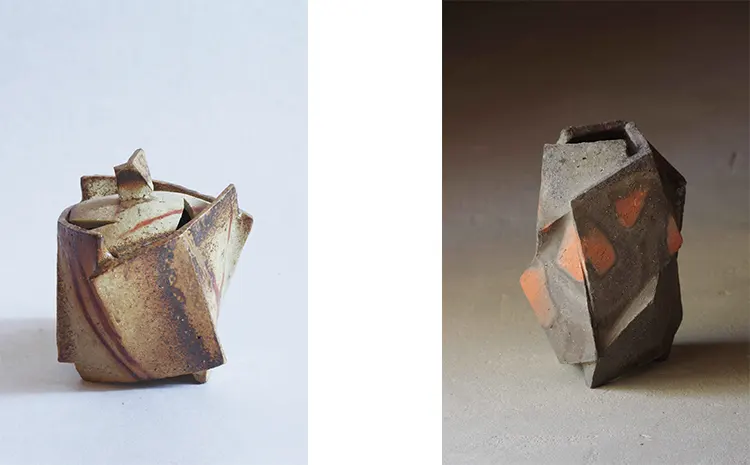
Hiroshi Toyofuku: Embracing the Genesis of Artistic Devotion
In the creative universe of Hiroshi Toyofuku, Jomon-style earthenware emerges as the genesis of his artistic devotion. The tactile allure and earthy hues of unglazed, wood-fired ceramics dominate his repertoire, forming the bedrock of his artistic journey. Toyofuku’s venture into other mediums remains uncharted territory, as the vast expanse of his chosen medium continues to ignite his curiosity and aspiration.
Toyofuku’s quest for exploration is primarily directed towards understanding the transformative power of different clays and firing methods on the final ceramic piece. This exploration is no brief affair; it demands substantial time and an unwavering commitment, narrowing his bandwidth to delve into alternate expressive avenues.
Toyofuku, despite lacking formal education in sculpture or design, has honed his skills in shaping forms through his rigorous practice of pottery making. The artist’s approach to form-building encapsulates the philosophy of a potter, with careful consideration given to every component of the ceramic vessel. From the base and foot, through the body, and onto the mouth, each element is meticulously crafted, giving rise to pieces that radiate innovation and originality.
With a deep-seated belief in the uniqueness of unglazed pottery produced in wood-fired kilns, Toyofuku recognizes that only a handful of locales across the globe specialize in this art form, which beautifully captures the myriad expressions of the firing process. Anchoring this belief is his visionary project: to thrust Bizen Pottery into the global spotlight.
Toyofuku envisions a future where this traditional Japanese art form garners the recognition and appreciation it rightly deserves. His aspiration is not merely to introduce the world to Bizen Pottery but to elevate it to a universally acclaimed status, celebrated for its distinctive and captivating characteristics.
